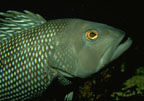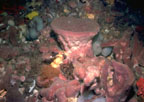|

|
The dusky flounder
(Syacium papillosum) is usually left
unnoticed buried and camouflaged by sand. click
image for more...(photo: Dean De Philipo /
Passage Productions)
|
|

|
The Great barracuda
(Sphyraena barracuda) has a long, torpedo
shaped body. Gray to green back with silvery
click image for more.... (photo: Dr. Matt
Gilligan/ Savannah State Univ.)
|
|

|
The Black Sea Bass
(Centropristis striata) ,also known as
Blackfish, has short, Blue-black with white areas
on head. click image for more... (photo:
Karen Roeder)
|
|

|
The leopard toadfish
(Opsanus pardus) has a large, flat head and
a large mouth with fleshy projections around it.
They spend most click image for more...
(photo: Karen Angle)
|
|

|
Blue angelfish
(Holacanthus bermudensis) have a protuberant
mouth filled with many small teeth used for nipping
at corals and other invertebrates. (photo: Karen
Angle)
|
|

|
Loggerhead sea turtles
(Caretta caretta) are commonly seen at
Gray's Reef basking on the ocean's surface,
swimming, click image for more... (photo:
Henry Ansley/Georgia DNR)
|

|
These red branching sponges,
(Ptilcaulis spiculifera), are found all
along the live bottom habitat at Gray's Reef. They
usually have numerous tubes that extend from the
main branch from the base mass.
(photo: Steve Gittings, Marine
Sanctuaries Division)
|
|

|
These sponges are sometimes
also called the stinking vase sponge (Ircinia
campana) since they emit a terrible odor once
removed from the water. (photo: Grays Reef
NMS)
|
|

|
Amorphous sponges, as this lobate morph stinker
sponge,(Ircinia campana) serve as hiding
places for small fish such as this belted sand
fish, (Serranus subligarius). (photo: Bruce
Cowden)
|
|

|
Encrusting tunicates are commonly found at
Gray's Reef. They vary in color and size and are
often found growing over sponges and bryozoans.
(photo: Karen Angle)
|
|

|
Colonial Tunicate
(Symplegma rubra): These orange, yellow, and
red colonies make bright colored patches click
image for more... (photo: Dean De Philipo /
Passage Productions)
|

|
The Regal sea fan
(Lophogorgi hebes) is a type of fanlike soft
corals (gorgonians) consisting of a meshwork of
calcium carbonate spicules surrounding an inner
core of click image for more... (photo:
Henry Ansley / Georgia DNR)
|
|

|
The orange ridged sea star
(Echinaster spinulosus) has orange yellow
spines. It five legs with small tube feet in the
under side which are used click image for
more...(photo: Grays Reef NMS)
|
|

|
The extremely long legs and
cone like body of Yellow line arrow crabs
(Stenorhynchus seticornis) makes click
image for more... (photo: Dean De Philipo /
Passage Productions)
|
|

|
Sea slugs are uncoiled snails
(mollusks) that have no shell and are have external
gills (cerata). The regal sea goddess
(Hyselodoris edenticulata) click image
for more... (photo: Dean De Philipo / Passage
Productions)
|
|

|
These American tube anemones
(Ceriantheopsis americanus) have a worm like body
made of nematocysts (stinging cells). (photo: Dean
De Philipo / Passage Productions)
|
|

|
Comb jellies are extremely
fragile transparent bioluminescence organisms that
do not sting. click image for more...
(photo: Dr. Matt Gilligan/Savannah State
Univ.)
|
|

|
Nurse sharks
(Ginglymostoma cirratum) have nasal barbels
(fleshy projection) used to find food, and click
image for more... (photo: Dr. Matt Gilligan /
Savannah State Univ.)
|





